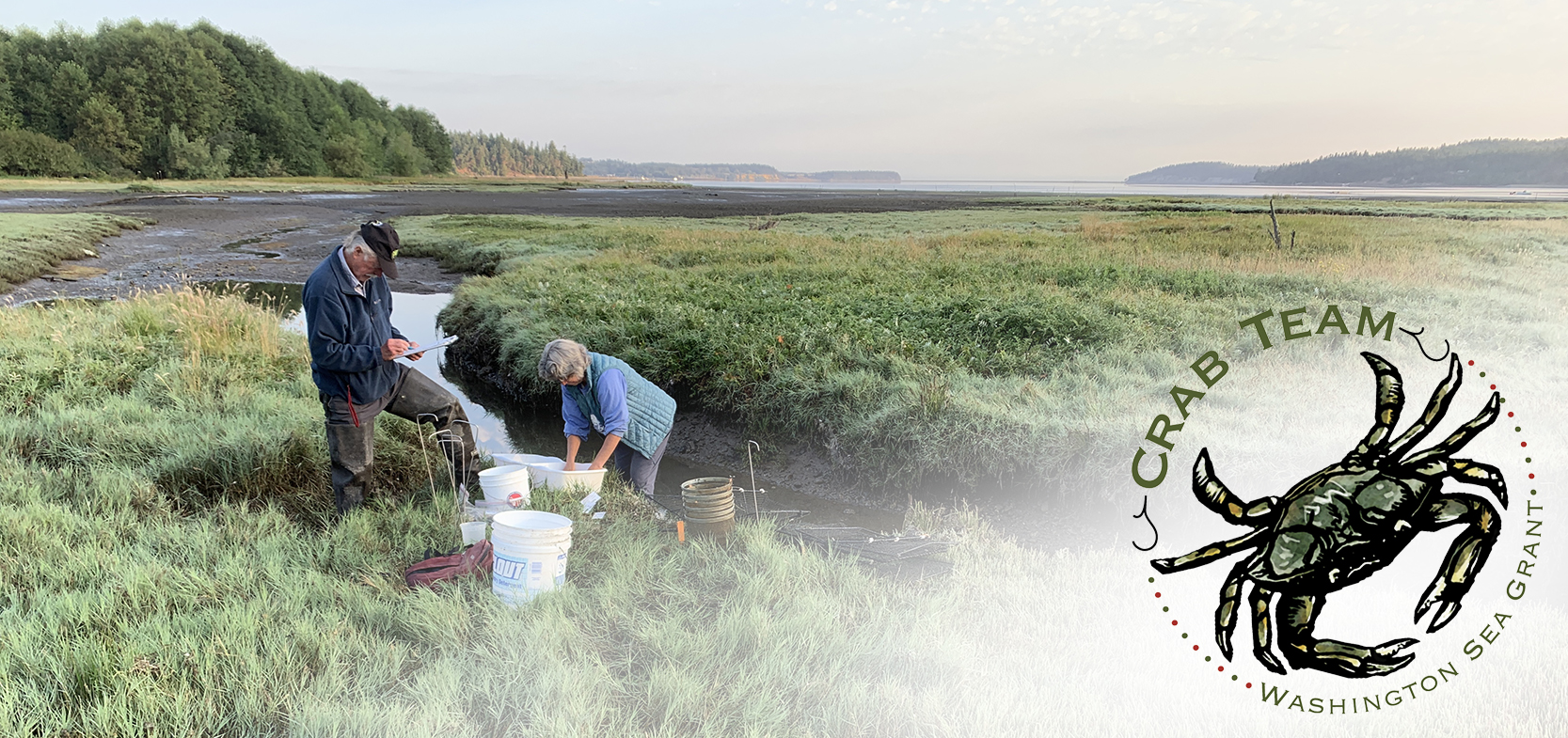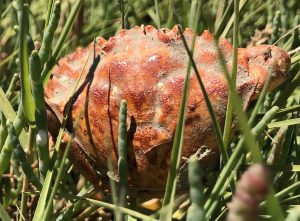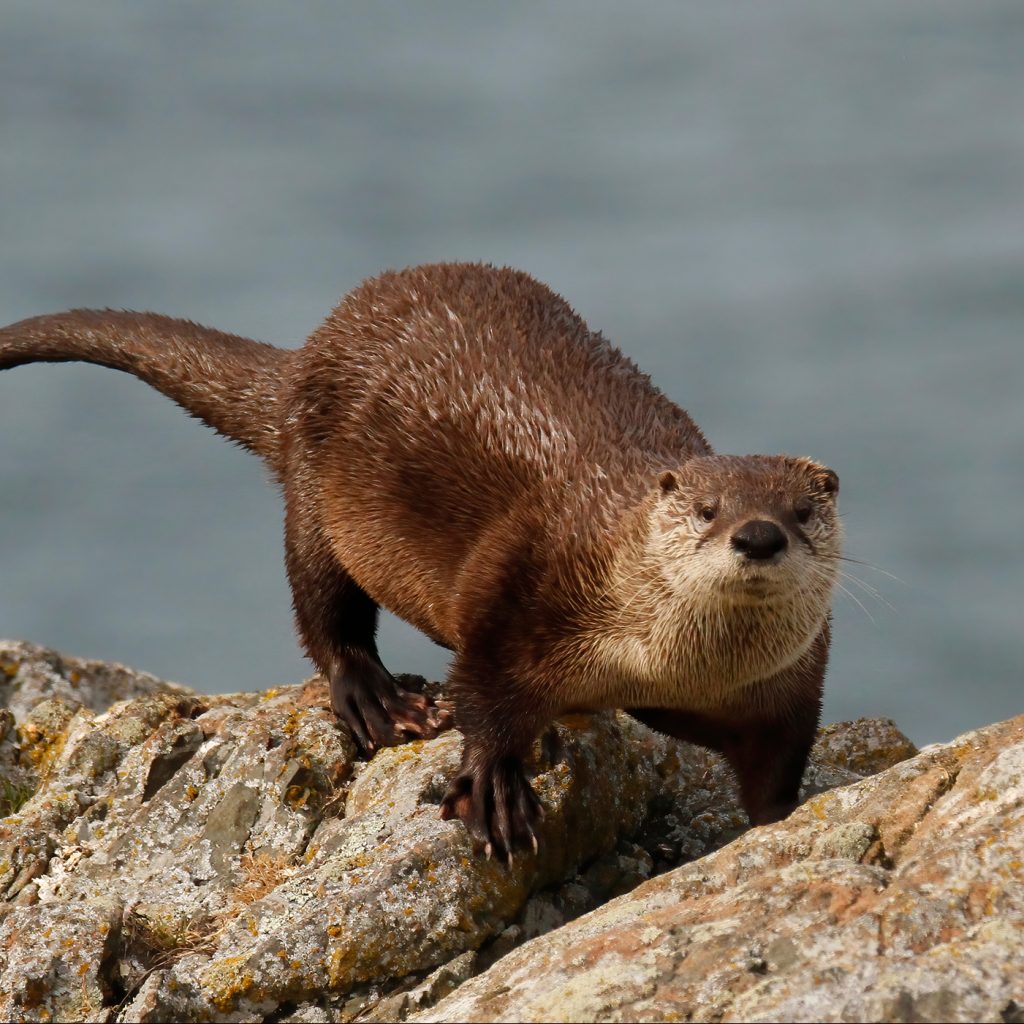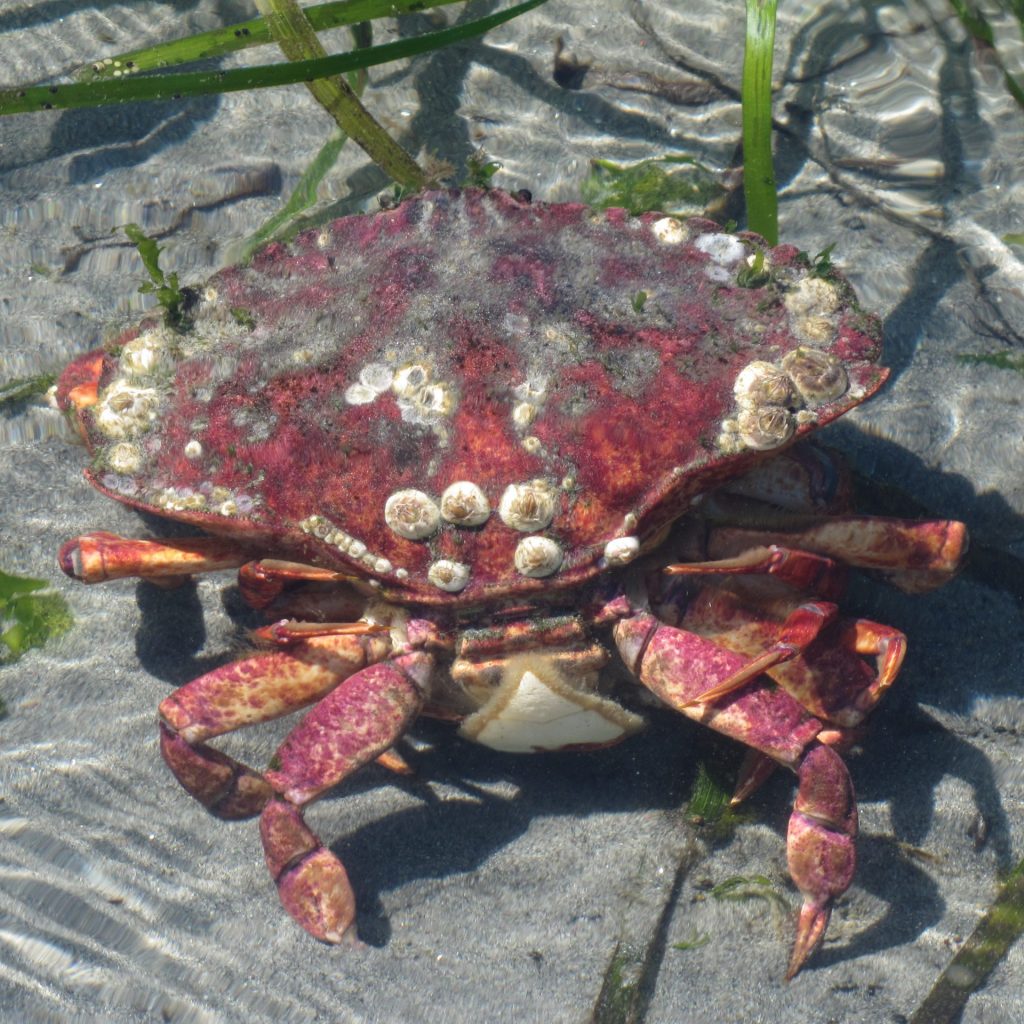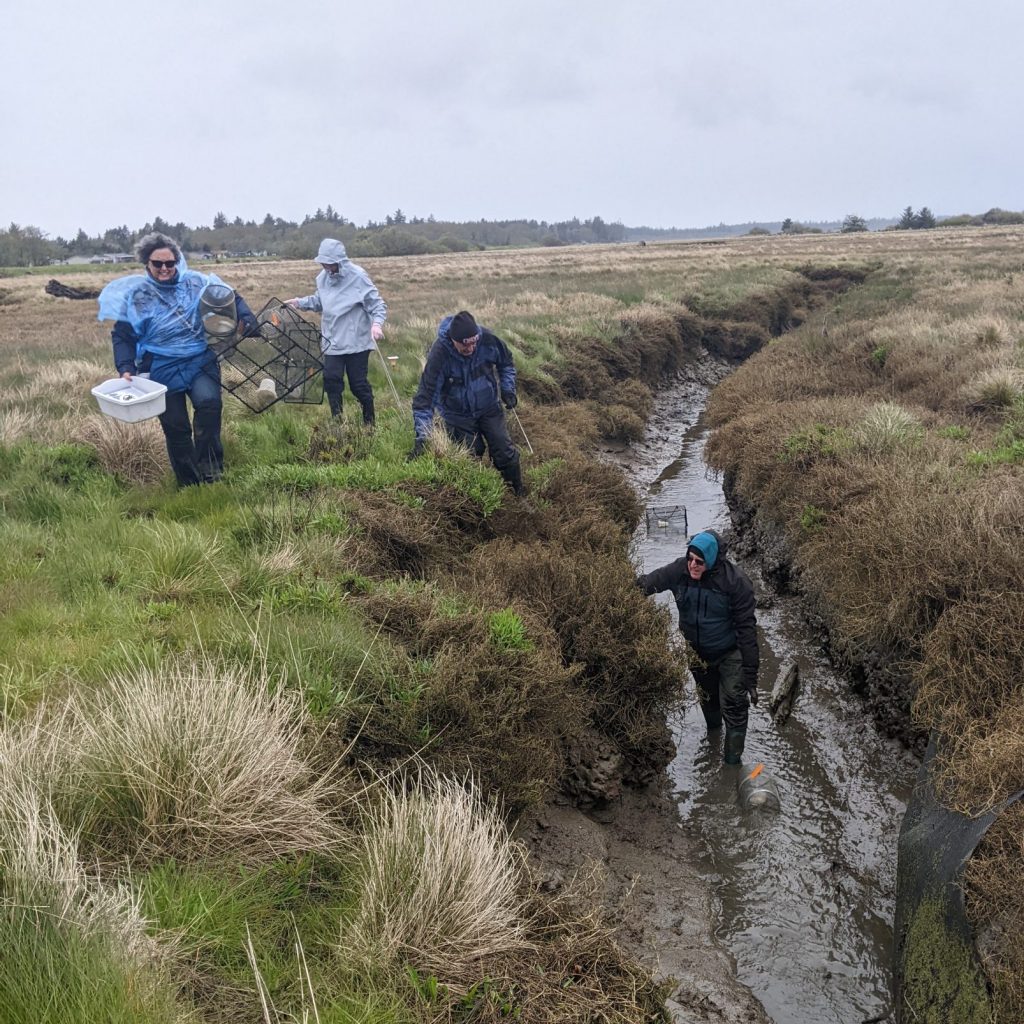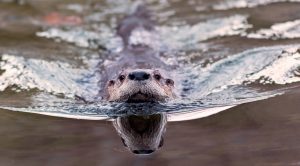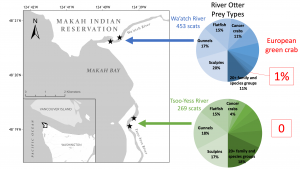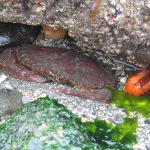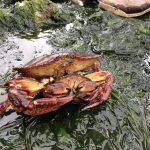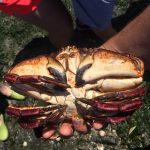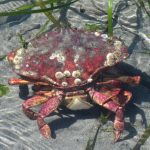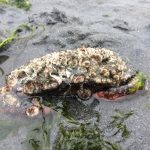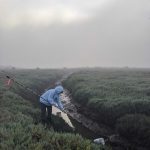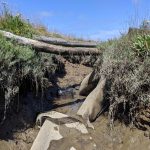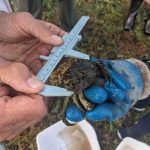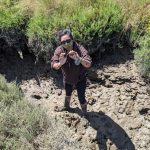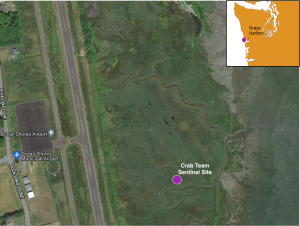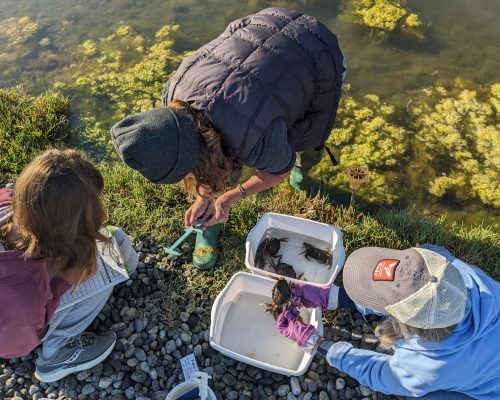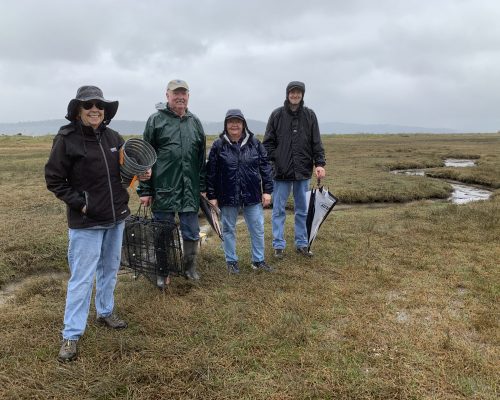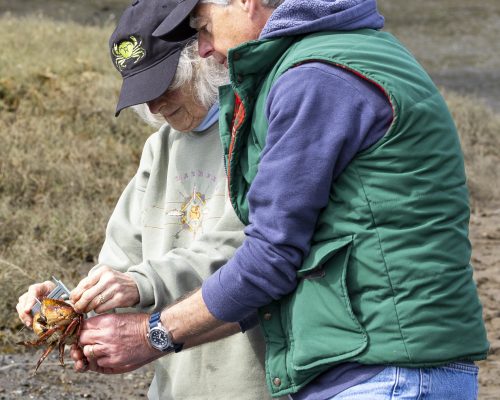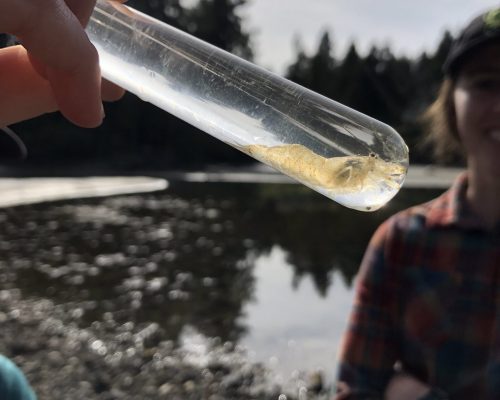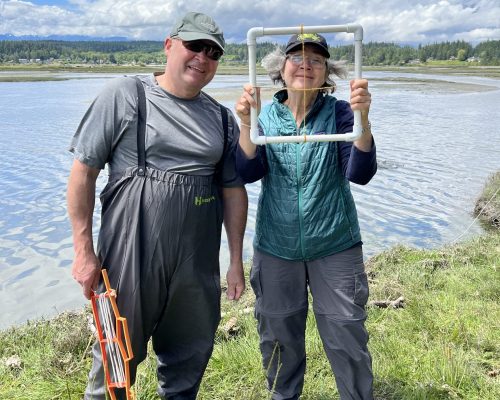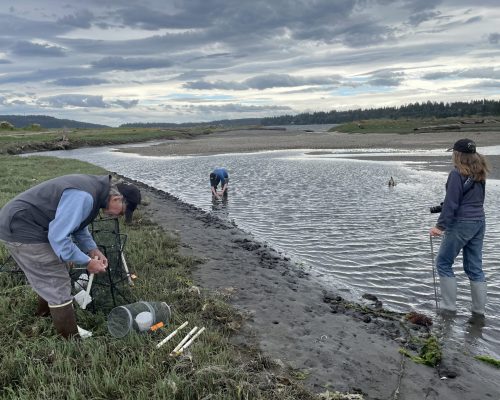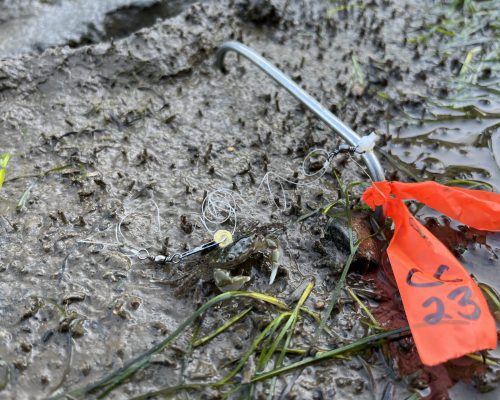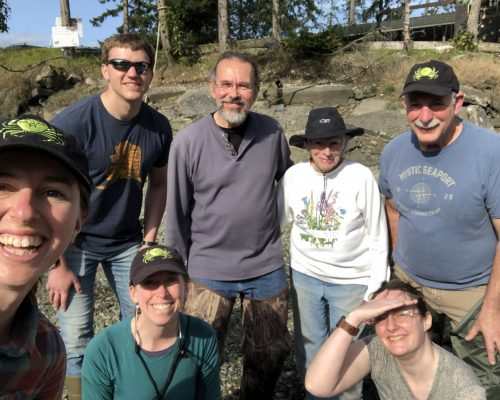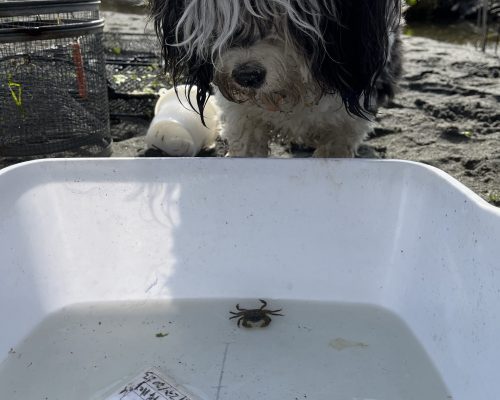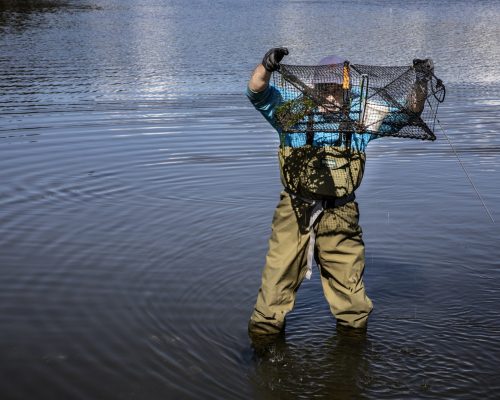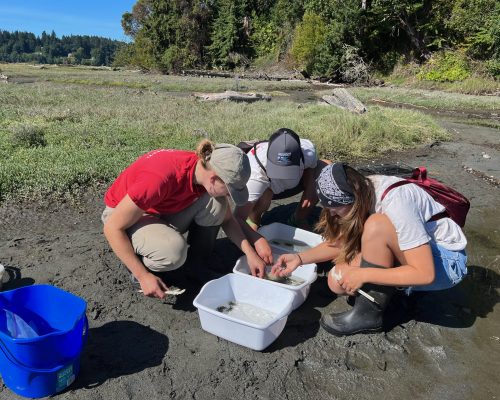Crabbing Is A Team Sport
November, 2023
Since Washington declared an emergency related to the European green crab invasion nearly two years ago, managers and scientists have dramatically grown state capacity to understand and control green crab populations. In this issue, we highlight the growth of the Crab Team monitoring network to include sites in coastal estuaries, spotlighting Ocean Shores. We also feature two potential local “team members” in the effort to control green crab populations, native river otters and red rock crabs. These are two species that will likely interact with, and possibly even prey on green crabs, so they also deserve a moment in the spotlight!
 Our biggest growth project this past year has been to launch a new program: Molt Search! In collaboration with partners at WSU Extension, Molt Search is the region’s newest effort to harness the dedication and interest of beachgoers in expanding early detection efforts along inland shorelines. Essentially, Molt Search hits the beach with a simple molt survey protocol – nearly identical to the protocol already being conducted by monitors at 67 Crab Team sites monthly. But the goal here is to unleash these searches across all shorelines of inland Washington, with data submission via the MyCoast app. The goal is to get many more folks out searching beaches for evidence of possible green crab presence, and it takes very little to get involved. We can’t wait to see families, clubs, vacationers, school groups … bachelorette parties (hey, why not?) out on beaches combing the wrack for green crab shells. Check out the Molt Search page to learn how you can get involved.
Our biggest growth project this past year has been to launch a new program: Molt Search! In collaboration with partners at WSU Extension, Molt Search is the region’s newest effort to harness the dedication and interest of beachgoers in expanding early detection efforts along inland shorelines. Essentially, Molt Search hits the beach with a simple molt survey protocol – nearly identical to the protocol already being conducted by monitors at 67 Crab Team sites monthly. But the goal here is to unleash these searches across all shorelines of inland Washington, with data submission via the MyCoast app. The goal is to get many more folks out searching beaches for evidence of possible green crab presence, and it takes very little to get involved. We can’t wait to see families, clubs, vacationers, school groups … bachelorette parties (hey, why not?) out on beaches combing the wrack for green crab shells. Check out the Molt Search page to learn how you can get involved.
Managing green crab is an all hands – and paws, and claws – effort. We’re excited to get to be a part of training and trapping alongside a host of new partners in the effort, from shellfish growers, tribes, agencies, and many more. As WSG Crab Team rounds the corner to our 10th (!) year, the name Team takes on a whole new meaning.
All our pinchy best,
Crab Team HQ
A Little Help From Some Friends? River Otter Diet in Makah Bay and What It Means for European Green Crab
Guest contributor Bobbie Buzzell conducted her Master’s research at Western Washington University looking at river otter diets in Makah Bay. She currently works as a green crab biologist for Lummi Natural Resources where she has been trapping green crab since 2021.
Food webs offer a visual understanding “who eats who” in the natural world. Interconnectedness of food webs can be lost with the loss or gain of even a single species, and sometimes, these changes can cause ecosystem collapse.
Arguably one of the most famous food web connections, discovered in the 1970s, was the role of sea otters (Enhydra lutris) in nearshore communities along the coast of California. Scientists found that sea urchins heavily feasted on kelp beds, turning once lush kelp forests into biodiversity deserts. Sea otters are a major predator of sea urchins and so, have a heavy influence on limiting sea urchin populations, but had been hunted out of most of their historic range in the northeast Pacific Ocean. In areas where sea otters were able to re-establish along the California coast, sea urchin numbers dropped which in turn reduced grazing on kelp forests, allowing them to flourish once again and invite back a host of life. In this example, reintroducing sea otters back into a food web helped to stabilize the ecosystem. But adding species can create imbalances too, particularly when, like invasive green crab, the species is evolutionarily unfamiliar to the web.
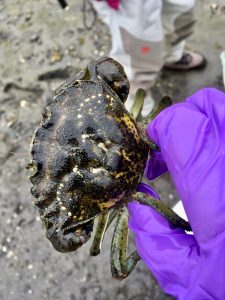
European green crab captured by Makah Fisheries. Could this evolutionarily novel crab be food for someone? Photo courtesy of Bobbie Buzzell
Green Crabs as Ecological Disruptors
Because of the impacts they have had elsewhere in the world, resource managers and scientists often draw awareness towards the species that green crabs might eat; and rightfully so—there is a lot of concern that green crabs will consume native crabs, juvenile clams and oysters, and alter tidal landscapes.
But on the opposite side of the food web, it’s also fair to ask: who might eat green crab?
Research on green crab from their native range in Europe and along established regions on the US East Coast tells us that green crabs in other parts of the world are heavily preyed on by a variety of creatures, including various species of fish, shore birds and mammals. Green crabs can also be their own worst enemy and can be heavily cannibalistic, which has shown to provide some level of population control in certain specific conditions.
As one might imagine, the green crab food web is quite intricate when incorporating both prey and potential predators, but documenting this dynamic is essential for predicting how green crab will integrate into new habitats and influence systems where they have already established. In the best-case scenario, local predators taking a fancy to green crab could offer passive and “natural” population control. While local predators will likely not eradicate green crab, they could help limit habitat use and abundance of green crabs.
Who are the best candidates for green crab predators? Some of the large native cancrid crabs, like red rock crabs, have been shown to kill (and eat?) green crabs – at least in the confines of laboratory experiments (read more in this issues Creature Feature). Some fish species like sculpins can be important predators of juvenile native crabs, and so they also might eat young green crabs.
So far, there are a few documented observations of possible predation on green crab in Puget Sound. In 2017, Crab Team monitors with the Padilla Bay NERR discovered a dismantled green crab along the bank of Big Indian Slough along with some mammal tracks believed to be either raccoon or river otter. In 2019, members of the public witnessed two separate instances of gulls eating green crabs in Whatcom County.
River Otters: Green Crab Predators?
While trapping along the Wa’atch River in the summer of 2018, green crab trappers with the Makah Tribe stumbled upon an odorous river otter (not to be confused with sea otters which are a different species) latrine—latrines are where river otters mark and defecate as a way of communicating among groups or individual river otters. Based on where the latrine had been found, it was clear river otters were foraging in areas where green crab were being captured. Could river otters be eating green crab?
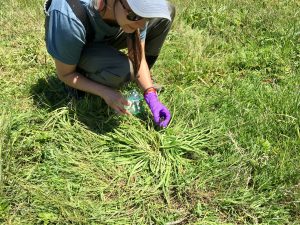
Bobbie Buzzell collects river otter scat samples as part of her master’s research at Western Washington University to determine what otters are eating, and whether they might prey on green crabs.
Between 2018 and 2019, I was part of a team with the Makah Fisheries department, and we collected more than 700 scats at latrines from banks along the Wa’atch River and Tsoo-Yess River estuaries. Identifying physical remains from scat is not a simple task. By the time prey passes through the digestive tract, it is a jumbled mess of fragments and pieces, but with careful attention to detail and some investigative science, a comprehensive snapshot of diet can be reconstructed.
Among all the river otter scats sieved through, 11 of 453 scats collected along the Wa’atch estuary contained remnants of green crab, and none of the 269 scats collected from the Tsoo-Yess latrines contained evidence of green crab. Young Dungeness crabs were the most commonly eaten crustacean, followed by crayfish. Because fish tend to comprise a large portion of river otter diet in marine habitats, it was not surprising that green crab consumption was low. However, it was a surprise scats did not contain any green crab on the Tsoo-Yess, where abundances of green crab have been typically higher than in the Wa’atch. We also looked at numbers of Dungeness crabs that were incidentally trapped with green crab—young Dungeness crabs were overall a lot more numerous than adult green crabs in both rivers.
River otter diet often reflects prey that are most abundant and easy to catch in their environment. In freshwater habitats, river otters consume a variety of smaller fishes like sculpins, and hard-shelled creatures such as crayfish. In marine and estuarine areas, their diet becomes a bit more complex with a higher diversity of prey—in our study alone there were more than 30 prey families recorded! Some of the rarer prey species might turn up in their diet by sheer luck while actively searching for food; for example, a washed-up carcass, or fish stuck in the intertidal after the tide recedes.
If you have ever handled a green crab, you know they can be quite feisty, and river otters might think so too. Green crabs are also adept hiders, either burrowing into the mud or taking refuge in eelgrass or other vegetation. Either scenario might make green crabs less preferred or findable than Dungeness crab or a large batch of schooling fish.
It felt anti-climactic that river otters were not eating as many green crab as we had hoped—such a relationship might have indicated more predatory forces were at work than we were aware of. But one thing was clear—river otters at Makah are recognizing green crab as a bite to eat and the concept of river otters acting as a natural mitigator of green crab is not off the table. While river otters are unlikely to eradicate green crab, they could help keep numbers in check if green crab populations reach higher densities, but follow-up is needed. This study provided a baseline of river otter diet during the early stages of green crab invasion in Makah Bay. Since the completion of this study, a new project is underway to hopefully reveal if river otters are eating more green crabs following a significant population increase there. No doubt the increase is concerning, but when there is more crab, there is more to eat.
-Bobbie Buzzell
You can access the full thesis here or the published note with Fishery Bulletin here.
Citation: Buzzell. B.M., A.M. Akmajian, A. Acevedo-Gutierrez. (2023) Exploring the biotic resistance of the invasive green crab (Carcinus maenas) by examining the diet of North American river otters (Lontra canadensis). Fishery Bulletin. 121 (1-2): 30-35. DOI: 10.7755/FB.121.1-2.3.
King Crush: Crab Team’s Red Rock Wrecking Ball
Though we are crab-crazy here at Crab Team, there are a number of crab species we don’t encounter as often as our heroes, HEOR, even if they are widespread and abundant in our region. One such character is the beefcake of the boulders, red rock crabs (Cancer productus, CAPR in Crab Team-ese). Compared to other species of “cancer” crabs, like graceful and Dungeness crabs, we don’t catch many rock crabs at Crab Team monitoring sites. This is largely because sites are chosen for their suitability for survival of young European green crabs – we want monitoring to be sensitive to the early stages of arrival of the invasive. But it turns out that red rocks are actually one native species that has a demonstrated history of being very effective at outcompeting and eating green crabs, even of similar size (Hunt et al. 2003). So we tend to select sites for early detection where we don’t expect to see rock crabs.
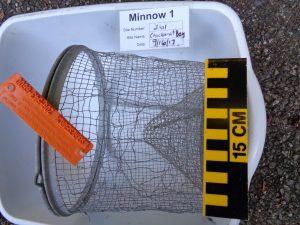
Back in 2017, monitors at Chuckanut Bay used to regularly catch large rock crabs. It’s likely this unsuspecting minnow trap was standing in between one of these crabs and the irresistible mackerel bait. Being too large to fit through the entrance, the crab took matters into its own claws.
Crab Teaming Red Rocks
That said, there are a number of network sites where red rock crabs are trapped and few where they are even common. Through 2022, about a quarter of inland Crab Team sites had found at least one red rock crab in a trap and 10 percent of sites had collected 10 or more. Then there’s Blakely Harbor, where the monitoring team regularly pulls up several dozen rock crabs a month in their 6 traps (current record is 63 in September 2021!). Cumulatively, they’ve racked up nearly 1,000 red rocks since starting the site in 2016, accounting for almost 70% of all red rocks captured in Crab Team data. Sites with many red rocks, like Blakely, as well as Kiana, Fidalgo Trestle, and a few others, often see more wear and tear on their minnow traps, and it seems likely this is because rock crabs damage the traps trying to get in even though they can’t fit through the small openings! Thankfully for our traps, these sites are the exception in the trapping data. But even if they aren’t living at all the Crab Team sites, we do see signs of red rock regional abundance in molt surveys – all but a handful of Crab Team sites have reported at least one rock crab molt at their site.
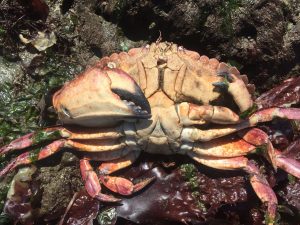
Claws are the defining feature of rock crabs. This crab’s right claw is full size, and the claw on the right is regrowing and has a lot of catching up to do to bring this crab back to fighting weight! Photo: WSG/Jeff Adams
King Klaw
Without a doubt, what makes rock crabs the undisputed intertidal heavyweight are their claws. As crabologist Sean McDonald likes to say, rock crabs “look like they spent too much time on arm day at the gym.” Rock crab claws are built for crushing. We can see this in not only the size of claws, but also their color, shape and dentition (yes, claws with teeth! Even more terrifying!). Rock crab claws are tall relative to their length, providing greater mechanical advantage for crunching (Yamada et al. 1998). The black tips of claws, which are also evident on a few other local species, are actually evidence of denser shell material at that part of the claw (Melnick et al. 1996), which helps rock crabs avoid damaging their claws when tackling tough prey like clams and snails. This suggests the rather astonishing possibility that their claw muscles are so strong that without reinforcement, they could break their own claws in trying to crush prey. And lastly, don’t forget those teeth! The bumps on the inside of the claws, referred to as dentition, are rounded and smooth, also helping reinforce the strength of the shell surface, and how effectively they can crunch apart the shells of other species.
For comparison, consider the claws of Dungeness crabs, which are quite long for their height, and can’t exert as much force for crushing relative to rock crabs. Additionally, the dentition of Dungie claws is relatively sharp, or serrated. Compared to rock crabs, Dungies are better adapted to subduing softer bodied prey. Or, when they tackle the same type and size of food, rock crabs and dungies use different strategies: rock crabs tend to crunch, but Dungies will doggedly chip and peel away at the opening of a snail until they can reach the soft body inside.
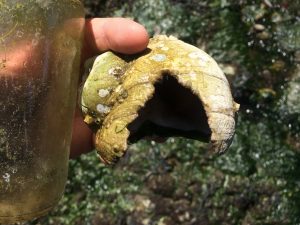
This moon snail likely fell victim to the steady chipping of a red rock crab. The snail could only retreat so far! Photo: WSG/Jeff Adams
Muscle Beach
That said, even rock crabs will meet their match from time to time. A great example of an age-old “arms race” is that between crabs and snails. Rock crabs are such important predators of a number of species of snail, that the snails have evolved both physical and behavioral defenses in response to the threat of getting eaten by this species. Moon snails, those molluscan leviathans often detected through their sand collar egg cases on beaches, have evolved such thick shells that even rock crabs can only get at them by shell peeling. The frilly varices of the aptly named leafy hornmouth (Ceratostoma foliatum) grow so big to make it harder for rock crabs to crush them (Donovan et al. 1999).
Rock crabs even change the beaches without eating anything at all. Several native species of whelk (and at least one invasive species) actually stop feeding and hide just at the faintest whiff of a rock crab nearby (Bourdeau 2009a). The smell of rock crabs is also enough to cause the frilled dogwinkle (Nucella lamellosa) to change the shape of its shell, growing a thicker, more rotund shape and subduing its flamboyant namesake shell ornamentations, just to make it harder for rock crabs to hold and crush it (Palmer 1985, Bourdeau 2009b).
Of course, those claws aren’t just for acquiring food. If a male wants to keep his potential mate, he’s got to be able to brandish the big guns and hold his own against other suitors (while holding on to her). Without both fully developed claws, he’s at a disadvantage. That’s one of the reasons it’s not OK or legal in Washington’s recreational fishery to take a claw from a red rock and throw the crab back. While crabs do have special anatomical features that help them survive the loss of a claw, rapidly ripping off a claw can bypass those safety mechanisms, and crabs can bleed to death. Even if they lose a claw the “safe” way, those claws take at least three molts to grow back and a big crab won’t have enough molts left to replace a lost claw. That said, crabs can lose claws for lots of reasons, including escaping predators and in combat with competitors. It’s not uncommon to find red rocks missing or regrowing a claw. They may even compensate by beefing up their remaining claw (Brock et al., 1998).
Beach Bricks
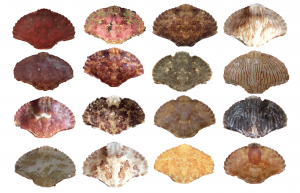
Juvenile rock crabs can have an incredible and festive range of colors and color patterns in their shells, including stripes and spots. Photos: WSG/Jeff Adams
While their bulky claws and surly personalities often give rock crabs a stodgy reputation, juveniles can be incredibly expressive. Rock-turning beach goers are often treated to a circus of patterns and colors of juvenile red rock crabs, ranging from black to white and from solid to zebra striped (Karuse-Nehring et al. 2010). Though as full grown adults, rock crabs don’t fear too much other than giant pacific octopuses, and a few terrestrial predators – our recreational fishery among them – as juveniles, rock crabs may use these outlandish patterns as disruptive camouflage. By adulthood, most rock crabs have settled into a more conformist middle-aged coloration of a brownish red that makes them look something like old bricks partially buried in the sand.
Beyond red rocks, we also have a few other species of rock crab in Washington, including the pygmy rock (Glebocarcinus oregonenesis, GLOR), which is just cute as a button and not a lot bigger than one, and the Pacific rock crab (Romaleon antennarius, ROAN), which is similar to a red rock but with pointier carapace teeth and lots of red spots on its underside. The Pacific rock tends to be on the Pacific coast but can be found in the Strait of Juan de Fuca. A couple other small rock crab species can be found in Pacific coast nooks and crannies but don’t appear to be found in the Salish Sea. Both the pygmy and Pacific have been found in Crab Team molt searches and – very, very rarely – in traps as well. You might note that all these species have black tips on the claws – beware!
The Great Red Hope
It’s fair to ask the question of why, if these beach bruisers are so fearsome, we include a few sites where rock crabs are thriving in the early detection monitoring network. Aren’t these sites likely to be “safe” from green crabs? It’s true that in most places trapped for green crabs across the state right now, finding a red rock crab in your trap is a sure bet you won’t get any green crabs at that location. Historic data in California shows the same pattern (Jensen et al. 2007). However, in some places where green crabs have been abundant for longer, like the west coast of Vancouver Island, scientists report increasing “encroachment” of green crab into habitats once dominated by red rocks. Crab Team sites like Blakely Harbor are interesting because, other than the presence of rock crabs, they actually look like good habitat for green crabs. Observations of whether or not green crab can survive at those sites will help us learn more about how effective rock crabs could be as biotic resistance – reducing the survival or keeping green crab out of certain habitats.
By monitoring a range of sites with different ecological communities of native organisms, Crab Team hopes to learn not only about the invasion of green crabs, but also about the interactions with native species. Time will tell who has the upper claw.
– Jeff Adams & Emily Grason
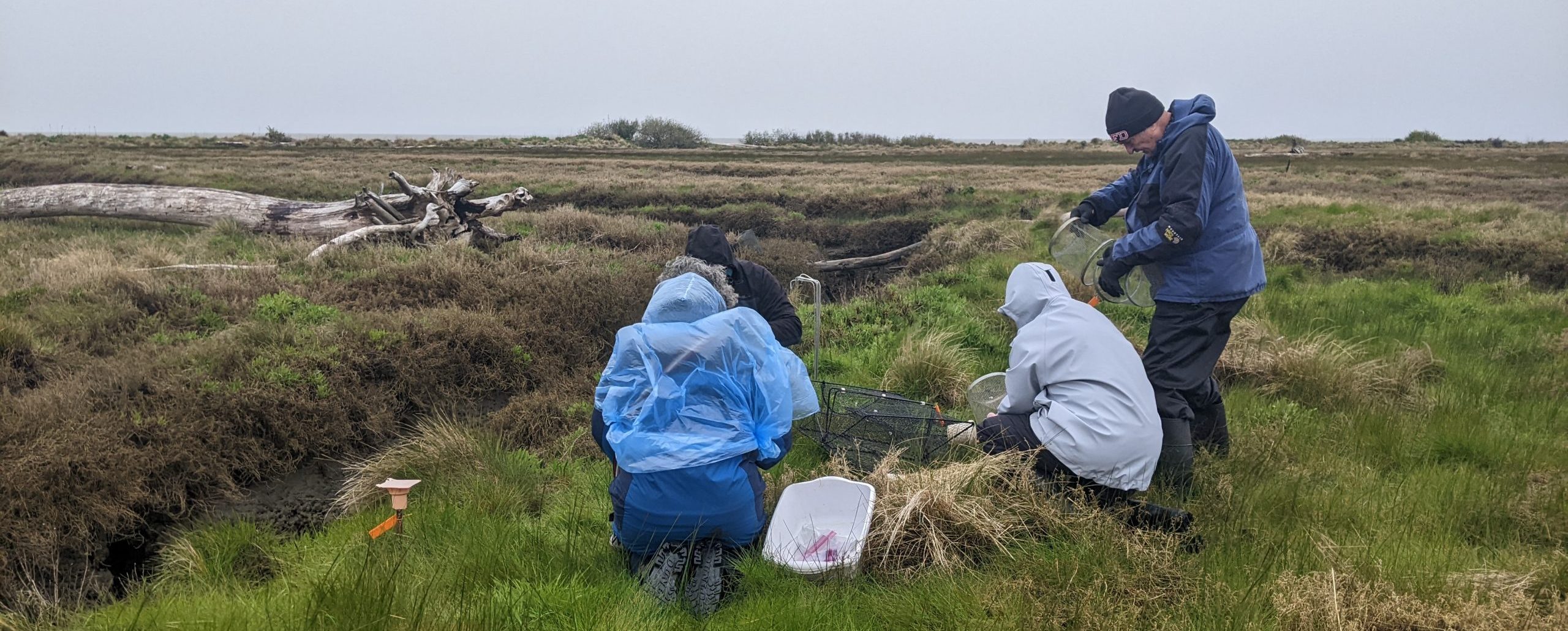
In this edition of Site Spotlight, we are excited to feature one of the WSG Crab Team network’s coastal sites for the first time ever! The growth, in 2020, of the Crab Team network to include sites in estuaries on Washington’s Pacific coast has increased the scope of what we can learn from monitoring. So, let us transport you to Ocean Shores in Grays Harbor, where you can find this Crab Team monitoring site sandwiched between a backdrop of shellfish beds and… a municipal airport?!
A Maze of Muddy Sloughs
The view from the Ocean Shores Municipal Airport parking lot looks out past the 3000-foot public airstrip and towards the wide open bay of Grays Harbor. From the ground, it’s hard to see just how extensive this channelized marsh habitat truly is. But those flying into the airport to take advantage of amazing clam digging and Washington’s ocean beaches get an excellent view of the branching sloughs carved between banks dressed in pickleweed. Driftwood is abundant and scattered throughout the habitat, with large resident logs often serving as bridges over narrow, steep-sided, channels that drop more than six feet to the mud below. Getting to the site marker involves some creativity in crossing, climbing, and sometimes even crawling over and around various gaps between solid ground. The channels themselves boast the kind of thick, gooey mud that makes sucking and squelching noises with each boot step sinking into and pulling out of the mucky bottom. And there’s evidence that we are not the only ones using this site, either. Coyotes have frequently been seen at dawn, and monitors observe scattered bones and skulls from deer. Scat from bears and perhaps other scavengers is not very difficult to find. All in all, despite being relatively close to town, this site is wild, a quality shared by many of the Crab Team coastal sites.
An Historic Location
In the early days of the European green crab invasion in Washington, Ocean Shores was one of the first trapping locations in the state. Trapping for green crab first occurred in Ocean Shores in 1998, when the Washington Department of Fish and Wildlife (WDFW) conducted an initial green crab population assessment survey in coastal estuaries. That year, though only 14% of the trapping effort in Grays Harbor took place in Ocean Shores, more than 90% of green crabs from the estuary were captured at this site (Figlar-Barnes et al. 2002)*. As the trapping continued through 2001, however, the green crab catch rates continually dropped pointing to a decline in green crab numbers in the area. These trends were consistent with WDFW trapping results from Willapa Bay during that same time – at both locations, green crabs would sometimes be so scarce as to be undetectible. This trend suggested that green crabs were not successfully established in Washington’s southwest estuaries at the time, and so green crab trapping was discontinued after 2001.
In 2020, when WDFW and Washington Sea Grant renewed trapping efforts on the coast, Ocean Shores was flagged as an area of interest based on the historic trap data and the prevalence of ideal habitat for green crab. A scouting trip with the Quinault Indian Nation in July of that year turned up several green crab molts and even a hand capture of a live green crab within just a few minutes of arriving at the site. This location immediately became a high priority for one of the very first coastal sites in the Crab Team network.
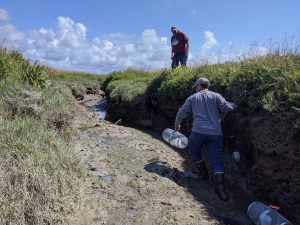
Quinault Indian Nation biologists, Joe Schumacker (on bank) and Alan Sarich (in channel) brave mosquitos and mud to accomplish their sampling in 2020.
Partnering in Stewardship
Shortly thereafter, the Quinault Indian Nation adopted the site during the pilot year of the sentinel site program, Crab Team’s expansion of monitoring trapping to sites in coastal estuaries. Quinault biologists Joe Schumacker and Alan Sarich led the charge during the most challenging year of sampling, ensuring that all protocols, Crab Team and COVID-related, were closely followed. Despite the strain on human resources in the year that followed, the Quinault site captains also ensured that Ocean Shores was fully sampled for the first full season, from April through September, in 2021. The team often quipped that the mosquitos at their site were worse than those of the Alaskan bush in the height of summer, but even that didn’t deter them from getting out there every month!
Having helped launch the site, the Quinault biologists were ready to pass the baton to other eager monitors during the following year and recommended the Coastal Interpretive Center as a partner. This seemed particularly fitting given the Center’s early beginnings as a WSG program called “Ocean Adventures” in 1977. Re-establishing this partnership in Ocean Shores felt like coming full circle. Dr. Barbara Hayford, the Center’s Director, was enthusiastic to assume monitoring responsibilities alongside committed board members and volunteers from the Center. Over the past two years, Bruce Rittenhouse has captained the team with members Bob Krueger, Cathey Peterson, Ann and Dick Bower, and Rachel Davey. Many of the monitors have had a career focused in environmental sciences, and have found this site a rewarding way to stay involved locally in scientific monitoring and outreach. “I enjoy working outdoors and on monitoring projects because I feel that I am contributing to science and conservation…. I really enjoyed learning about the different crabs and fish in our samples,” Dr. Hayford reflected after her first season. Thanks to these two extraordinarily dedicated teams, site #603 has not missed a month of sampling since its launch, now four years ago.
A Green Crab Hotspot
On resuming green crab trapping at Ocean Shores in 2020, the site again emerged as a “hotspot” given its high population density, consistent with observations from two decades before. Over the past three years, both Crab Team site surveys and larger scale removal efforts have shown that, compared to other locations in Grays Harbor, Ocean Shores has one of the highest relative abundances of green crabs in the estuary. The site has captured green crabs during every month of monitoring, for a grand total of 136 green crabs captured in 120 trap sets over four monitoring seasons (Figure 1). Size data from the crabs captured reveals that multiple age classes, from young-of-the-year to adults, are present at the site, pointing to the establishment of a local population that had been living at this site for several years prior to 2020 (see Protocol in Focus for more information on how we determine this). Noticeably, catch rates were lower during this past 2023 season than in previous years of sampling, which is something we are interested in exploring more in the data.
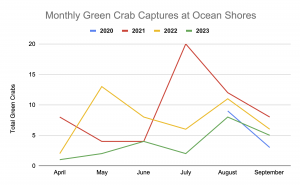
Figure 1. Total number of European green crabs (CAMA) captured each sampling month at site 603 since the site launched in August 2020. Click to enlarge
One possible explanation for Ocean Shores’ relatively higher densities of green crabs is likely proximity to the mouth of Grays Harbor. This location might make it more susceptible to larval input from sources outside of the bay, such as larger populations of green crabs to the south, as far as Oregon and California. After entering the estuary, the planktonic larvae are swept along with the tides and currents that eddy north around Damon Point and settle within the protected, channelized sloughs of Ocean Shores, which are perfect protective habitat for juveniles.
…and the Usual Suspects
Meanwhile, when it comes to native species, this site has many similarities to the others in our network. Hairy shore crabs, staghorn sculpins, three-spined sticklebacks, are common captures, and the occasional prickly sculpin and sand shrimps will also sneak into traps. Monitoring a site like Ocean Shores, where green crabs are present alongside native species that we detect elsewhere in our network, might provide insight into what we could see in other places in the state as the European green crab invasion unfolds. Data from this location, and most of the coastal sentinel sites, are therefore valuable in multiple ways: They can tell us what’s happening at this site specifically, and they can also guide our mental model when thinking about sites that don’t yet have green crabs, but might in the future.
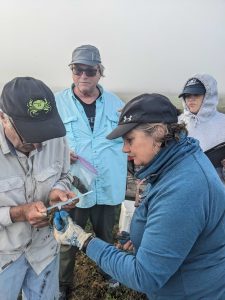
The Ocean Shores team measures one of the green crabs captured in August of 2023. Photo: WSG/Lisa Watkins
At the same time, sustaining the monitoring long term allows us to track the relative abundance of native species and green crabs over time, and gain insight into potential interactions between them. For obvious reasons, there is a strong sense of urgency to understand the impacts that green crabs could have (or are having) on native ecosystems and resources. In that regard, collectively, we still have some work ahead – measuring impacts is often challenging at the early stages of invasions. One reason is there simply hasn’t been much time for impacts to have accumulated. Green crab numbers, even in coastal estuaries, have only boomed in the last several years, and are likely still climbing. So it might take time for green crabs to rack up multiple years and generations of predation impacts on, for instance, hairy shore crabs, in order that we would be able to detect changes in those populations of native species. In addition, in Grays Harbor we face an additional challenge: because there was a long gap in trapping for green crabs in coastal estuaries, the baseline data needed to be able to compare coastal sites pre- and post-invasion don’t exist. It’s just not possible to measure changes without a starting point, so we have to use other data sources to infer what the changes might have been and which changes might have been caused by green crabs. In this case, it takes more sites, and a bit longer to get a confident understanding of how green crabs might be changing the local ecology.
But with the Crab Team network of monitors we are headed in the right direction. Thanks to the dedication of Crab Team network monitors like the Quinault biologists and volunteers with the Coastal Interpretive Center, we are collectively building the first dataset of its kind to help unveil what’s happening in our estuaries as they are facing an increasing threat from green crabs.
–Alex Stote
*Figlar-Barnes, Ronald A., B.R. Dumbauld, A. Randall, and B.E. Kauffman. 2002. Monitoring and Control of European Green Crab (Carcinus maenas) Populations In Coastal Estuaries of Washington State. Report to Washington State Department of Fish and Wildlife. 45 pp. This report is not publicly available online. Please contact Crab Team (crabteam@uw.edu) to request a copy.
Header image caption: The Coastal Interpretive Center took on this site in 2021, launching in April despite the wind and rain! From left to right: Dr. Barbara Hayford, Cathey Peterson, Bob Krueger, and Bruce Rittenhouse. Photo: WSG/Alex Stote
Photo Gallery
We love to get the virtual experience of monitoring with all of the Crab Team volunteers. Do you have a photo to share? Send it to crabteam@uw.edu. (Click on arrows to scroll, and photos to enlarge for more detail.)
